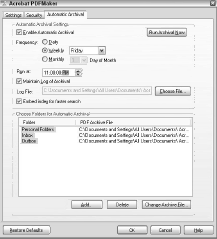Converting Outlook Files to PDF
Whereas the Acrobat PDFMaker in Microsoft Internet Explorer may appear stale and without many new features or any kind of special menu commands, the Acrobat PDFMaker in Microsoft Outlook is a major development in Acrobat 8 and supports many unique features for PDF conversion. Just click the Adobe PDF menu and look over the menu commands you find in Microsoft Outlook’s Acrobat PDFMaker.
With the exception of Start Meeting all the commands in the Outlook Adobe PDF menu differ from all the other PDFMakers. The menu choices are as follows:
- Convert to Adobe PDF. Select this menu item and a submenu opens with two other menu choices. The first menu choice in the submenu is Selected Messages. You can select multiple messages for PDF conversion. When you convert the mail messages to PDF, the messages are combined into a PDF Package.
The second menu choice is Selected Folders. Choose this item and the Convert folder(s) to PDF dialog box opens. The dialog box lists all your mail folders. You can select any of the folders where you want to convert the folder contents to PDF. But wait! There’s more!
Both these menu options are truly great new features in Acrobat 8. Selecting either submenu command creates a PDF Package of your selected files or your folder files. During the creation process a search index file is created and embedded in the PDF Package.
Not only are the mail messages converted to PDF, but you can also preserve file attachments, package files with digital signatures, package file attachments protected with Acrobat Security, and package Adobe LiveCycle Designer XML forms attachments.
Note that although you can add secure PDF files to a PDF Package you need a password to open all files that protect the file from opening with a password. When your PDF Package is created and you open the package in Acrobat. Click any one of the titles at the top of the list and your mails are sorted on the item you select.
For example, clicking on Subject sorts your mails in alpha order according to subject. Click From and the sort changes to an alpha order according to those who sent you the mails. Not to be forgotten in the packages created from Outlook’s Acrobat PDFMaker is the embedded index file produced with each package.
When you open the Search pane and search while viewing any file in the package, your search is performed on the embedded index file. Searches are faster using the index file over searching documents, folders and using the Find toolbar.
- Set up automatic archival. Another great new feature in Acrobat 8 and PDF packaging is the option for automatically archiving files. Select this menu command and the Acrobat PDFMaker dialog box opens with the Automatic Archival tab selected.
In this dialog box you can specify the interval you want for your file archives, setting up a log file that records all the archive activity, embedding an index file, choose the folders you want to archive, and choose the host file you want to append your new documents to.
- Change Conversion Settings. Like the other PDFMakers, the Change Conversion Settings command opens the Acrobat PDFMaker dialog box. In addition to a few features you have with other PDFMakers, an option for including file attachments is provided as is a page layout area where you can define page sizes and margins.
Notice the tab for Automatic Archival can also be selected from the Change Conversion Settings menu command and clicking the Automatic Archival tab.
- Migrate Old PDF Archives to PDF Packages. If you created PDFs in Acrobat version 7 from the Outlook PDFMaker, you can migrate those older PDF documents into the newer PDF Package format. In PDF Archives crated with Acrobat 7 is was difficult to determine which attachments went with which e-mail. This new feature in Acrobat 8 makes your archives easier to work with.

